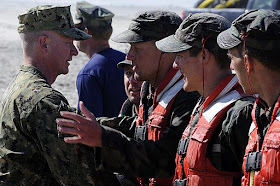(Special thanks to shipmate Nancy Harrity for this guest review of two books that explore what science reveals about human nature and how those lessons can be applied by Navy leaders to motivate their teams.)
By Nancy Harrity
With budgets decreasing and demands on our teams increasing, the best leaders are looking at what they can do differently to motivate their teams and improve morale.
Author Daniel H. Pink looks into if what we know about motivation is true in Drive: The Surprising Truth About What Motivates Us. He finds there is a gap between what science knows about what works and how leaders actually motivate people.
Most Navy leaders have been taught some variation of reward what you want more of and punish what you want less of – an extrinsic, or outside of oneself, model. According to Pink, this approach is all wrong because it doesn’t account for how we organize what we do, how we think about what we do nor how we actually do what we do. Pink explains that carrots and sticks don’t work because they extinguish intrinsic motivation, diminish performance, crush creativity, crowd out good behavior, encourage cheating, shortcuts and unethical behavior, become addictive and foster short-term thinking – all things that helped to create many of the issues we face today. So what has science learned that can help us effectively motivate our teams?
 |
| Master Chief Petty Officer of the Navy Rick D. West, left, congratulates Basic Underwater Demolition/SEAL Class 290 upon their completion of Hell Week, Aug. 5, 2001. |
Pink discusses how scientific studies have uncovered that motivation must come from within and has three essential elements – autonomy, mastery and purpose. Autonomy means focusing on results and allowing your team members to work on their own terms as much as possible. To foster mastery of the work at hand, leaders need to match what their teams must do with what their team members can do and like to do as much as possible, as well as allowing the activities to be their own reward. To foster purpose, leaders must allow their team members to find a way to do what is meaningful to each of them. Leaders also need to answer the question of why the work is being done and how it fits into the bigger picture.
Lastly, Pink notes that constant rewards can transform interesting tasks into drudgery and play into work. He advises his readers to shift from “if you do this, then you’ll get that” type of rewards in favor of the occasional “now that you’ve accomplished this,” type rewards. He also advises considering the use of non-tangible rewards such as praise and feedback.
In The 5 Languages of Appreciation in the Workplace by Gary Chapman and Paul White provide leaders with some concrete suggestions on how to use non-tangible rewards in the workplace. Many Sailors may recognize the five languages from Chapman’s The 5 Languages of Love from Fleet and Family Service Center homecoming briefs.
The concept is a simple evolution of the basic communication model. As with the five love languages, everyone has a way or language that he likes to receive appreciation in. Message of appreciation (and of love, and in general for that matter) are best received when they are sent in the language valued most by the recipient, not the language most valued by the sender. Chapman and White point out that many supervisors miss the mark when they try to show appreciation to their team members because they express their appreciation in the language they, as the senders respond best to, not the language the intended recipient responds best to.
The five languages are:
- Words of Affirmation – using words to convey a positive message to the person you wish to show appreciation to, the classic “atta boy.” When using words of affirmation, take care to keep in mind that the recipient may prefer private, one-on-one recognition over a public awards ceremony, or a written note over the spoken word. Words of affirmation are most effective when they are specific and speak to the individual’s character or his personality.
- Quality Time – giving the person you wish to appreciate your undivided attention for a period of time. Quality time can take many forms from working closely together on a project, to small group dialogue, to quality conversation or even shared experiences.
- Acts of Service – helping the person you wish to show appreciation to do what he does the way he does it. When offering acts of service, volunteer, ask before you help, do whatever it is the way the recipient would, finish what you start and most importantly, check your attitude.
- Tangible Gifts – giving a gift the person you wish to show appreciation to. When giving tangible gifts, give the recipient a gift that he values – it could be time off, a small token or an experience.
- Physical Touch – giving the person you wish to show appreciation an appropriate, affirming, non-sexual touch. Tread carefully when using physical touch as not everyone wants to be touched.
As you prepare for the New Year, take some time, look into yourself and consider how you might use these approaches to make 2012 your team’s best year yet.
-------------
-------------
(Coming soon, a look at what Sailors were reading on Dec. 7, 1941.)



No comments:
Post a Comment